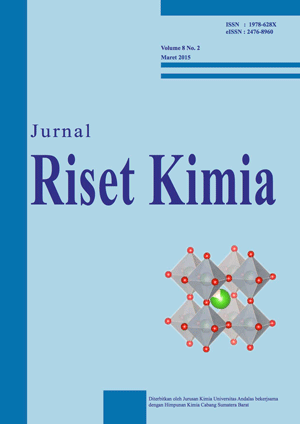REACTION KINETICS OF Cu ELECTRO-DEPOSITION ON THE SURFACE OF TiO2/GRAPHITE
DOI:
https://doi.org/10.25077/jrk.v8i2.228Keywords:
Cu Electro-deposition, TiO2/Graphite, Kinetics of electrode reaction.Abstract
Research on the kinetics of electrode reaction during copper electro-deposition on the surface of TiO2/graphite has been conducted. The aims of this research are to determine the ratio of anodic reaction rate to cathodic reaction rate , the ratio of anodic rate constant to cathodic rate constant , the equilibrium constant when the reaction reach equilibrium condition and to study the polarization in the electro-deposition reaction. Copper was deposited electrochemically from CuSO4 solution at various concentration i.e. 0.1 M; 0.2 M; 0.3 M; 0.4 M; 0.5 M. In every 5 minutes during electro-deposition process, the pH changes in anode cell was recorded and the change of Cu2+ concentration was also analyzed by spectrophotometric method. The result shows that the reaction order of Cu2+ reduction is first order and the oxidation of H2O in anodic cell is zero order. The ratio of anodic rate constant to cathodic rate constant, is 4.589´10-3 ± 0.071´10‑3. It indicates that the reaction rate in cathode is larger than the reaction rate in anode and it allowed polarization. The electrochemical cell reached equilibrium after 25 minutes with the equilibrium constant is 8.188´10-10 ± 1.628´10-10.
References
Yang, H., Coombs, N., Sokolov, L., and Ozin, G. A., 1997, Registered Growth of Mesoporous Silica Films on Graphite, J. Mater. Chem, 7(7), 1285-1290.
Rahmawati, F., Kusumaningsih, T., Hapsari, A.M., Hastuti, A., 2010, Ag and Cu loaded on TiO2/graphite as a catalyst for Escherichia coli-contaminated water disinfection, Chemical Papers, 64 (5) 557-565.
Debnath, S., Ray, N.R., Ghosh, U.C., 2011, Characterization of agglomerated nanosized titanium (IV) oxide prepared by two pathways and their performance toward Cu (II) adsorption, International Journal of Green Nanotechnology 3, 271-280.
Brown, G.N., Birks, J.W., and Koval, 1992, Development and characterization of a titanium-dioxide based semiconductor photoelectrochemical detector, Analytical Chemistry, 64, 427-434.
Hoffman, M. R., Martin, S. T., Choi, W., and Bahnemann, D. W., 1995, “Environmental Applications of Semiconductor Photocatalysisâ€, Chem. Rev. 95, 69-96.
Zhu, J., Lu, M., Li, M., Zhu, J., Shan, Y., 2012, Synthesis of carbon-titania composite and its application as catalyst support, Material Chemistry and Physics 132, 316-323.
Gunlazuardi, J., 2001, Fotokatalisis pada Permukaan TiO2: Aspek Fundamental dan Aplikasinya, Seminar Nasional Kimia Fisika II, Universitas Indonesia, Jakarta.
Rahmawati, F., Wahyuningsih, S., Handayani, N., 2008, Surface modification of semiconductor thin film of TiO2 on graphite substrate by Cu-electro-deposition, Indonesian Journal of Chemistry, 8 (3) 331-336.
Li, P., Li, T.,Zhou, J.H., Sui, Z.J., Dai, Y.C., Yuan, W.K., Chen, D., 2006, Synthesis of carbon nanofiber/graphite-felt composite as a catalyst, Microporous Mesoporous Materials 95, 1-7.
Hanzu, I., Djenizian, T., Ortiz, G.F., Knauth, P., 2009, Mechanistic study of Sn electrodeposition on TiO2 nanotube layers: thermodynamics, kinetics, nucleation, and growth modes, Journal of Physical Chemistry 113, 20568-20575.
Prentice, G., 1991, in: Electrochemical Engineering Principles, Prentice Hall. Inc., New Jersey, 93-150.
Downloads
Published
How to Cite
Issue
Section
Citation Check
License
Please find the rights and licenses in Jurnal Riset Kimia (J. Ris. Kim). By submitting the article/manuscript of the article, the author(s) agree with this policy. No specific document sign-off is required.
1. License
The use the article will be governed by the Creative Commons Attribution license as currently displayed on Creative Commons Attribution 4.0 International License.Â
2. Author(s)' Warranties
The author warrants that the article is original, written by stated author(s), has not been published before, contains no unlawful statements, does not infringe the rights of others, is subject to copyright that is vested exclusively in the author and free of any third party rights, and that any necessary written permissions to quote from other sources have been obtained by the author(s).
3. User Rights
Under the Creative Commons license, the journal permits users to copy, distribute, and display the material for any purpose. Users will also need to attribute authors and J. Ris. Kim on distributing works in the journal and other media of publications.
4. Rights of Authors
Authors retain all their rights to the published works, such as (but not limited to) the following rights;
- Copyright and other proprietary rights relating to the article, such as patent rights,
- The right to use the substance of the article in own future works, including lectures and books,
- The right to reproduce the article for own purposes,
- The right to self-archive the article,
- The right to enter into separate, additional contractual arrangements for the non-exclusive distribution of the article's published version (e.g., post it to an institutional repository or publish it in a book), with an acknowledgment of its initial publication in this journal.
5. Co-Authorship
If the article was jointly prepared by more than one author, any authors submitting the manuscript warrants that he/she has been authorized by all co-authors to be agreed on this copyright and license notice (agreement) on their behalf, and agrees to inform his/her co-authors of the terms of this policy. J. Ris. Kim will not be held liable for anything that may arise due to the author(s) internal dispute. J. Ris. Kim will only communicate with the corresponding author.












